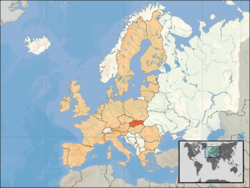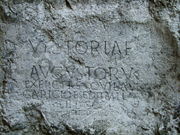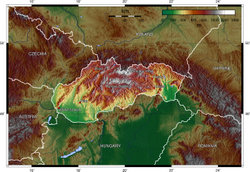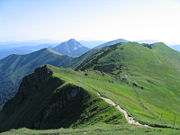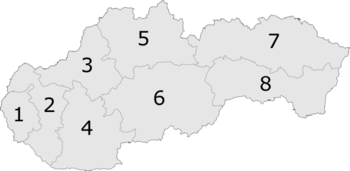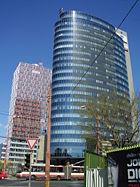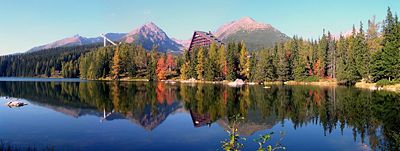Slovakia
2008/9 Schools Wikipedia Selection. Related subjects: Europe; European Countries
| Slovenská republika Slovak Republic
|
||||||
|---|---|---|---|---|---|---|
|
||||||
| Motto: "Afferant Montes Pacem Populo" "May mountains bring people peace" |
||||||
| Anthem: Nad Tatrou sa blýska "Lightning over the Tatras" |
||||||
|
Location of Slovakia (orange)
– on the European continent (camel & white) |
||||||
| Capital (and largest city) |
Bratislava |
|||||
| Official languages | Slovak | |||||
| Demonym | Slovak | |||||
| Government | Parliamentary republic | |||||
| - | President | Ivan Gašparovič | ||||
| - | Prime Minister | Robert Fico | ||||
| - | President of National Council | Pavol Paška | ||||
| Independence | Peaceful dissolution of Czechoslovakia | |||||
| - | Date | January 1, 19931 | ||||
| EU accession | May 1, 2004 | |||||
| Area | ||||||
| - | Total | 49,035 km² ( 130th) 18,932 sq mi |
||||
| - | Water (%) | negligible | ||||
| Population | ||||||
| - | 2001 census | 5,379,455 | ||||
| - | Density | 111/km² ( 88th) 287/sq mi |
||||
| GDP ( PPP) | 2007 estimate | |||||
| - | Total | $109.587 billion ( 59th) | ||||
| - | Per capita | $20,251 ( 41st) | ||||
| GDP (nominal) | 2007 IMF estimate | |||||
| - | Total | $74.103 billion ( 60th) | ||||
| - | Per capita | $13,857 ( 44th) | ||||
| HDI (2004) | ▲ 0.863 (high) ( 42nd) | |||||
| Currency | Slovak koruna2 (1 koruna = 100 haliers) ( SKK) |
|||||
| Time zone | CET ( UTC+1) | |||||
| - | Summer ( DST) | CEST ( UTC+2) | ||||
| Internet TLD | .sk² | |||||
| Calling code | +421³ | |||||
| 1 Czechoslovakia split into the Czech Republic and Slovakia; see Velvet Divorce. 2Slovakia will adopt the Euro as its currency on January 1, 2009 at a rate of €1 = 30.126SKK. ² Also .eu, shared with other European Union member states. ³ Shared code 42 with Czech Republic until 1997. |
||||||
Slovakia (long form: Slovak Republic; Slovak: Slovensko , long form Slovenská republika ) is a landlocked country in Central Europe with a population of over five million and an area of about 49,000 square kilometres (almost 19,000 square miles). The Slovak Republic borders the Czech Republic and Austria to the west, Poland to the north, Ukraine to the east and Hungary to the south. The largest city is its capital, Bratislava. Slovakia is a member state of the European Union, NATO, OECD, WTO, and other international organizations.
The Slavic people arrived in the territory of present day Slovakia between the 5th and 6th century AD during the Migration Period (Migration of Nations). Various parts of Slovakia belonged to Samo's Empire, the first known political unit of Slavs, Great Moravia, the Kingdom of Hungary, Habsburg (Austrian) monarchy, Austria-Hungary, Czechoslovakia throughout history. Slovakia became independent on January 1, 1993 with the peaceful division of Czechoslovakia in the Velvet Divorce.
Slovakia is a high-income economy with one of the fastest rates of growth in the EU and OECD. It joined the European Union in 2004 and will join the Eurozone on 1 January 2009.
History
Before the 5th century
From around 500 BC, the territory of modern-day Slovakia was settled by Celts, who built powerful oppida on the sites of modern-day Bratislava and Havránok. Biatecs, silver coins with the names of Celtic Kings, represent the first known use of writing in Slovakia. From 2 AD, the expanding Roman Empire established and maintained a series of outposts around and just north of the Danube, the largest of which were known as Carnuntum and Brigetio. Near the northernmost line of the Roman hinterlands, Limes Romanus there existed the winter camp of Laugaricio (modern-day Trenčín) where the Auxiliary of Legion II fought and prevailed in a decisive battle over the Germanic Quadi tribe in 179 AD during the Marcomannic Wars. The Kingdom of Vannius, a barbarian kingdom founded by the Germanic Suebian tribes of Quadi and Marcomanni, as well as several small Germanic and Celtic tribes, including the Osi and Cotini, existed in Western and Central Slovakia from 8–6 BC to 179 AD.
Slavic states
The Slavic tribes settled in the territory of Slovakia in the 6th century. Western Slovakia was the centre of Samo's Empire in the 7th century. A Slavic state, known as the Principality of Nitra, arose in the 8th century and its ruler Pribina had the first known Christian church in Slovakia consecrated by 828. Together with neighboring Moravia, the principality formed the core of the Great Moravian Empire from 833. The high point of this Slavonic empire came with the arrival of Saints Cyril and Methodius in 863, during the reign of Prince Rastislav, and the territorial expansion under King Svatopluk I.
Kingdom of Hungary
After the disintegration of the Great Moravian Empire in the early 10th century, the Hungarians gradually annexed the territory of the present-day Slovakia. In the late 10th century, south-western Slovakia became part of the arising Hungarian principality, which transformed to the Kingdom of Hungary after 1000. Most of Slovakia was integrated into the Kingdom of Hungary by c. 1100, north-eastern parts by c. 1300. For almost two centuries, it was ruled autonomously as the Principality of Nitra within the Kingdom of Hungary. Slovak settlements extended to northern and south-eastern present-day Hungary. The ethnic composition became more diverse with the arrival of the Carpathian Germans in the 13th century, Vlachs in the 14th century and Jews.

A huge population loss resulted from the invasion of the Mongols in 1241 and the subsequent famine. However medieval Slovakia was characterized rather by burgeoning towns, construction of numerous stone castles, and the development of art. In 1465, King Matthias Corvinus founded the first university in Bratislava, but it was closed in 1490 after his death.
After the Ottoman Empire started its expansion into Hungary and the occupation of Buda in the early 16th century, the centre of the Kingdom of Hungary (under the name of Royal Hungary) shifted towards Pressburg (now Bratislava), which became the capital city of the Royal Hungary in 1536. But the Ottoman wars and frequent insurrections against the Habsburg Monarchy also inflicted a great deal of destruction, especially in rural areas. As the Turks withdrew from Hungary in the late 17th century, Slovakia's importance within the kingdom decreased, although Bratislava retained its position as the capital city of Hungary until 1848, when the capital moved to Budapest.
During the revolution in 1848-49 the Slovaks supported the Austrian Emperor with the ambition to secede from the Hungarian part of the Austrian monarchy, but they failed to achieve this aim. During the period of the Austro-Hungarian Empire, from 1867 to 1918, the Slovaks experienced severe oppression in the form of Magyarization, promoted by the Hungarian government.
Czechoslovakia and World War 2
In 1918, Slovakia and the regions of Bohemia and Moravia formed a common state, Czechoslovakia, with the borders confirmed by the Treaty of Saint Germain and Treaty of Trianon. In 1919, during the chaos following the breakup of Austria-Hungary, Slovakia was attacked by the provisional Hungarian Soviet Republic and one-third of Slovakia temporarily became the Slovak Soviet Republic.
During the inter-war period, democratic and prosperous Czechoslovakia was under continuous pressure from the revisionist governments of Germany and Hungary, until it was finally broken up in 1939, as a result of the Munich Agreement concluded a year before. Southern Slovakia was lost to Hungary due to the First Vienna Award.
Under pressure from Nazi Germany, the First Slovak Republic, led by the clerical fascist leader Jozef Tiso, declared its independence from Czechoslovakia in 1939. However, the government was strongly influenced by Germany and gradually became a puppet regime. An anti-Nazi resistance movement launched a fierce armed insurrection, known as the Slovak National Uprising, in 1944. A bloody German occupation and a guerilla war followed. Most Jews were deported from the country and taken to German concentration camps during the Holocaust.
Communist era
After World War II, Czechoslovakia was reconstituted and Jozef Tiso was hanged in 1947 for collaboration with the Nazis. More than 76,000 Hungarians and 32,000 Germans were forced to leave Slovakia, in a series of population transfers initiated by the Allies at the Potsdam Conference. This expulsion is still a source of tension between Slovakia and Hungary.
Czechoslovakia came under the influence of the Soviet Union and its Warsaw Pact after a coup in 1948. The country was occupied by the Warsaw Pact forces in 1968, ending a period of liberalization under the leadership of Alexander Dubček. In 1969, Czechoslovakia became a federation of the Czech Socialist Republic and the Slovak Socialist Republic.
Establishment of Slovakia
The end of Communist rule in Czechoslovakia in 1989, during the peaceful Velvet Revolution, was followed once again by the country's dissolution, this time into two successor states. In July 1992 Slovakia, led by Prime Minister Vladimír Mečiar, declared itself a sovereign state, meaning that its laws took precedence over those of the federal government. Throughout the Autumn of 1992, Mečiar and Czech Prime Minister Václav Klaus negotiated the details for disbanding the federation. In November the federal parliament voted to dissolve the country officially on December 31, 1992. Slovakia and the Czech Republic went their separate ways after January 1, 1993, an event sometimes called the Velvet Divorce. Slovakia has remained a close partner with the Czech Republic and other countries within the Visegrad Group. Slovakia became a member of NATO on March 29, 2004 and of the European Union on May 1, 2004 .
Geography
The Slovak landscape is noted primarily for its mountainous nature, with the Carpathian Mountains extending across most of the northern half of the country. Amongst these mountain ranges are the high peaks of the Tatra mountains. To the north, close to the Polish border, are the High Tatras which are a popular skiing destination and home to many scenic lakes and valleys as well as the highest point in Slovakia, the Gerlachovský štít at 2,655 metres (8,711 ft), and the country's highly symbolic mountain Kriváň.
Major Slovak rivers are the Danube, the Váh and the Hron.
The Slovak climate lies between the temperate and continental climate zones with relatively warm summers and cold, cloudy and humid winters. The area of Slovakia can be divided into three kinds of climatic zones and the first zone can be divided into two sub-zones.
Climate of lowlands
Dominance of oceanic influences
The average annual temperature is about 9–10°C (48–50°F). The average temperature of the hottest month is about 20°C (68°F) and the average temperature of the coldest month is greater than −3°C (26°F). This kind of climate occurs at Záhorská nížina and Podunajská nížina. It is the typical climate of the capital city Bratislava.
Climate of lowlands with dominance of continental influences
The average annual temperature is about 8–9°C (46–48°F). The average temperature of the hottest month is about 19°C (66°F) and the average temperature of the coldest month is less than −3°C (26°F). This kind of climate can be found at Košická kotlina and Východoslovenská nížina. It is the typical climate of the city of Košice.
Climate of basins
The average annual temperature is between 5°C and 8.5°C (41–47°F). The average temperature of the hottest month is between 15°C and 18.5°C (59–65°F) and the average temperature of the coldest month is between −3°C and −6°C (21–26°F). This climate can be found in almost all basins in Slovakia. For example Podtatranská kotlina, Žilinská kotlina, Turčianska kotlina, Zvolenská kotlina. It is the typical climate for the towns of Poprad and Sliač.
Mountain climate
The average annual temperature is less than 5°C (41°F). The average temperature of the hottest month is less than 15°C (59°F) and the average temperature of the coldest month is less than −5°C (23°F). This kind of climate occurs in mountains and in some villages in the valleys of Orava and Spiš.
Demographics
The majority of the inhabitants of Slovakia are ethnically Slovak (85.8%). Hungarians are the largest ethnic minority (9.7%). Other ethnic groups, as of the 2001 census, include Roma with 1.7%, Ruthenians or Ukrainians with 1%, and other or unspecified, 1.8%.
The official state language is Slovak, a member of the Slavic Language Family, but Hungarian is also widely spoken in the south of the country and enjoys a co-official status in some municipalities, and many people also speak Czech.
The Slovak constitution guarantees freedom of religion. The majority of Slovak citizens (68.9 %) identify themselves with Roman Catholicism (although church attendance is lower); the second-largest group are people without confession (13%). About 6.93% belong to Lutheranism, 4.1% are Greek Catholic, affiliated with the Roman Catholic Church, Calvinism has 2.0%, other and non-registered churches 1.1% and some (0.9%) are Eastern Orthodox. About 2,300 Jews remain of the large estimated pre-WWII population of 90,000.
In 2007 Slovakia was estimated to have a fertility rate of 1.33. (i.e., the average woman will have 1.33 children in her lifetime), which is one of the lowest numbers among EU countries.
Politics
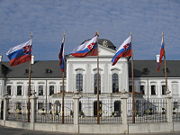
Slovakia is a parliamentary democratic republic with a multi-party system. The last parliamentary elections were held on June 17, 2006 and two rounds of presidential elections took place on April 3, 2004 and April 17, 2004.
The Slovak head of state is the president ( Ivan Gašparovič, 2004 - 2009), elected by direct popular vote for a five-year term. Most executive power lies with the head of government, the prime minister ( Robert Fico, 2006 - 2010), who is usually the leader of the winning party, but he/she needs to form a majority coalition in the parliament. The prime minister is appointed by the president. The remainder of the cabinet is appointed by the president on the recommendation of the prime minister.
Slovakia's highest legislative body is the 150-seat unicameral National Council of the Slovak Republic (Národná rada Slovenskej republiky). Delegates are elected for a four-year term on the basis of proportional representation. Slovakia's highest judicial body is the Constitutional Court of Slovakia (Ústavný súd), which rules on constitutional issues. The 13 members of this court are appointed by the president from a slate of candidates nominated by parliament.
Slovakia is a member state of the European Union and NATO since 2004. As a member of the United Nations (since 1993), Slovakia was, on October 10, 2005, elected to a two-year term on the UN Security Council from 2006 to 2007. Slovakia is also a member of WTO, OECD, OSCE, and other international organizations.
Regions and districts
As for administrative division, Slovakia is subdivided into 8 kraje (singular - kraj, usually translated as "region", but actual meaning is "county"), each of which is named after its principal city. Regions have enjoyed a certain degree of autonomy since 2002. Their self-governing bodies are referred to as Self-governing (or autonomous) Regions (sg. samosprávny kraj, pl. samosprávne kraje) or Upper-Tier Territorial Units (sg. vyšší územný celok, pl. vyššie územné celky, abbr. VÚC).
- Bratislava Region (Bratislavský kraj) (capital Bratislava)
- Trnava Region (Trnavský kraj) (capital Trnava)
- Trenčín Region (Trenčiansky kraj) (capital Trenčín)
- Nitra Region (Nitriansky kraj) (capital Nitra)
- Žilina Region (Žilinský kraj) (capital Žilina)
- Banská Bystrica Region (Banskobystrický kraj) (capital Banská Bystrica)
- Prešov Region (Prešovský kraj) (capital Prešov)
- Košice Region (Košický kraj) (capital Košice)
(the word kraj can be replaced by samosprávny kraj or by VÚC in each case)
The "kraje" are subdivided into many okresy (sg. okres, usually translated as districts). Slovakia currently has 79 districts. The districts are then subdivided into zuj ("village" or "municipality").
In terms of economics and unemployment rate, the western regions are richer than eastern regions; however the relative difference is no bigger than in most EU countries having regional differences.
Economy
Slovakia has pursued a difficult transition from a centrally planned economy to a modern, high-income market economy. Major privatizations are nearly complete, the banking sector is almost completely in private hands, and foreign investment has picked up.
Slovakia is characterized by the sustained high economic growth. In 2006, Slovakia reached the highest growth of GDP (8.9%) among the members of OECD. The annual GDP growth in 2007 is estimated at 10,4%, with the record level of 14,3% reached in the fourth quarter.
Unemployment, peaking at 19.2% at the end of 2001, decreased to 7.84% in February 2008 according to the Statistical Office of the Slovak Republic. In addition to the economic growth, migration of workers to other EU countries also contributed to this reduction. According to Eurostat, which uses calculation method different from that of the Statistical Office of the Slovak Republic, the unemployment rate is still the highest in the EU at 9.9%.
Inflation dropped from an average annual rate of 12.0% in 2000 to just 3.3% in the election year 2002, but it rose again in 2003-2004 because of increases in taxes and regulated prices. It reached 3.7 % in 2005.
Slovakia will adopt the euro currency on 1 January 2009 as the 16th EU country to do so and has already entered the ERM II for this purpose. The euro in Slovakia was approved by the European commission on 7 May 2008. The Slovak koruna was revalued on 28 May 2008 to 30.126 for 1 euro, which will also be the exchange rate for the euro.
Slovakia is an attractive country for foreign investors mainly because of its lower labour cost, low tax rates and well educated labour force. In recent years, Slovakia has been pursuing a policy of encouraging foreign investment. FDI inflow grew more than 600% from 2000 and cumulatively reached an all-time high of $17.3 billion USD in 2006, or around $18,000 per capita by the end of 2006.
Despite a sufficient number of researchers and a solid secondary educational system, Slovakia, along with other post-communist countries, still faces many challenges in the field of modern knowledge economy. The business and public research and development expenditures are well below the EU average. The Programme for International Student Assessment, coordinated by the OECD, currently ranks the Slovak secondary education as the 30th in the world (placing it just below the United States and just above Spain).
In March 2008, the Ministry of Finance announced that Slovakia's economy is developed enough to stop being an aid receiver from the World Bank. Slovakia will become an aid provider by the end of 2008.
Tourism
Slovakia features natural landscapes, mountains, caves, medieval castles and towns, folk architecture, spas and ski resorts.
More than 1.6 million people visited Slovakia in 2006, and the most attractive destinations are the capital of Bratislava and the High Tatras. Most visitors come from the Czech Republic (about 26%), Poland (15%) and Germany (11%).
International rankings
- Human Development Index 2006: Rank 42nd out of 177 countries
- Index of Economic Freedom 2006: Rank 34th out of 157 countries
- Reporters Without Borders world-wide press freedom index 2007: Rank 3rd (along with Estonia) out of 169 countries
- Global Competitiveness Report ranking 2006-2007: Rank 37th out of 125 countries.
- Corruption Perceptions Index 2007: Rank 49th out of 180 countries.
- PISA 2006: Rank 27


